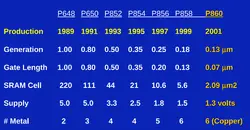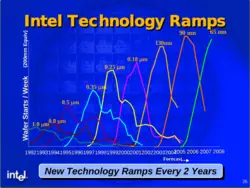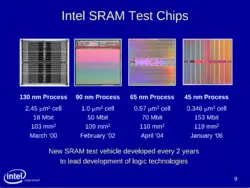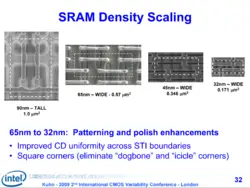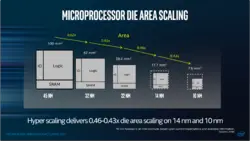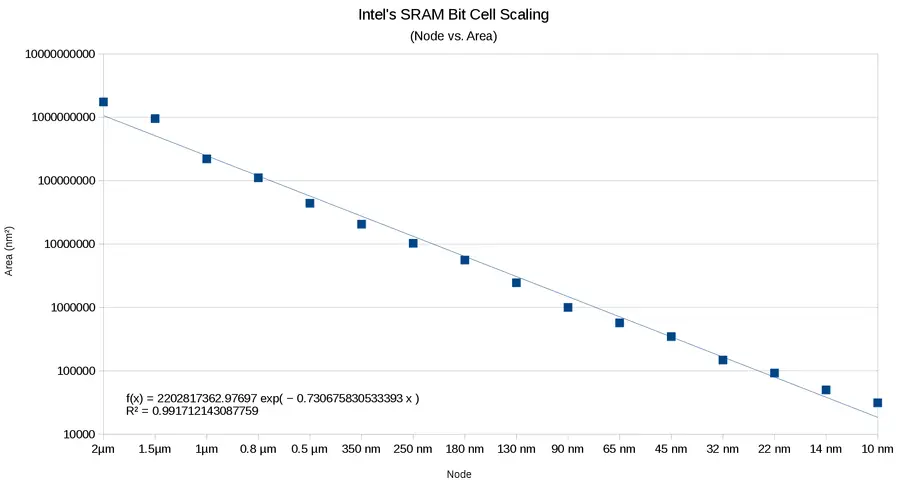(→Timeline) |
(→Timeline) |
||
| (13 intermediate revisions by 4 users not shown) | |||
| Line 4: | Line 4: | ||
== Overview == | == Overview == | ||
The table below shows the history of Intel's process scaling. Values were taken from various Intel documents including IDF presentations, ISSCC papers, and IEDM papers. Note that while a great deal of effort was put into ensuring the accuracy of the values, some numbers vary to a small degree between Intel's own documents and therefore discrepancies may exist. [[SRAM]] bitcell areas refer to a high-density 6T bitcell with the exception of the very first few processes where smaller cell designs were used. Additionally, the metal layer count is for the client dies (example consumer mobile & desktop); server models utilize considerably more layers. Finally, from the [[45 nm]] node, Intel has switched to utilizing a [[high-κ]] material, therefore the oxide thickness shown refers to the [[equivalent oxide thickness]] instead. | The table below shows the history of Intel's process scaling. Values were taken from various Intel documents including IDF presentations, ISSCC papers, and IEDM papers. Note that while a great deal of effort was put into ensuring the accuracy of the values, some numbers vary to a small degree between Intel's own documents and therefore discrepancies may exist. [[SRAM]] bitcell areas refer to a high-density 6T bitcell with the exception of the very first few processes where smaller cell designs were used. Additionally, the metal layer count is for the client dies (example consumer mobile & desktop); server models utilize considerably more layers. Finally, from the [[45 nm]] node, Intel has switched to utilizing a [[high-κ]] material, therefore the oxide thickness shown refers to the [[equivalent oxide thickness]] instead. | ||
| + | |||
| + | == Nomenclature == | ||
| + | Intel has been using the same naming scheme for decades. All process technologies (including packaging technologies) begin with a 'P' followed by the [[wafer size]] and the process ID. Generally, the process ID is an auto-increment value with odd values generally reserved for SoC and I/O (low power) devices while the even values have been used for Intel premier line of high-performance processors. | ||
| + | |||
| + | [[File:intel process naming scheme.svg|400px]] | ||
| + | |||
== Timeline == | == Timeline == | ||
| Line 15: | Line 21: | ||
[[File:intel 90nm 32nm yield.png|250px|thumb|[[90 nm]] to [[32 nm]]]] | [[File:intel 90nm 32nm yield.png|250px|thumb|[[90 nm]] to [[32 nm]]]] | ||
[[File:intel scaling from 45nm to 10nm.png|250px|thumb|Intel scaling from [[45 nm]] to [[10 nm]]]] | [[File:intel scaling from 45nm to 10nm.png|250px|thumb|Intel scaling from [[45 nm]] to [[10 nm]]]] | ||
| + | [[File:intel scaling roadmap to 5nm.png|250px|thumb|Intel roadmap from [[10 nm]] to [[5 nm]] and an advance packaging roadmap.]] | ||
<div style="overflow-x: scroll; white-space: nowrap; min-width: 300px" class="scrollable"> | <div style="overflow-x: scroll; white-space: nowrap; min-width: 300px" class="scrollable"> | ||
<table class="wikitable" style="text-align: center;"> | <table class="wikitable" style="text-align: center;"> | ||
<tr><th>Year</th><th>Process</th><th>[[technology node|Node]]</th><th>MLayers</th><th>µarchs</th><th>Gate</th><th>Interconnects</th><th colspan="4">Attributes</th></tr> | <tr><th>Year</th><th>Process</th><th>[[technology node|Node]]</th><th>MLayers</th><th>µarchs</th><th>Gate</th><th>Interconnects</th><th colspan="4">Attributes</th></tr> | ||
| + | {{intel proc tech |year=1972 |name=PMOS I |mlayers=1 |node=10 µm | ||
| + | |archs=4004 | ||
| + | |a1=Gate Dielectric |d1=SiO<sub>2</sub> | ||
| + | |a2=L<sub>g</sub> |d2=10.0 µm | ||
| + | }} | ||
| + | {{intel proc tech |year=1974 |name=HMOS I |mlayers=1 |node=8 µm | ||
| + | |archs= | ||
| + | |a1=Gate Dielectric |d1=SiO<sub>2</sub> | ||
| + | |a2=L<sub>g</sub> |d2=8.0 µm | ||
| + | }} | ||
| + | {{intel proc tech |year=1976 |name=HMOS II/III |mlayers=1 |node=6 µm | ||
| + | |archs=8080 | ||
| + | |a1=Gate Dielectric |d1=SiO<sub>2</sub> | ||
| + | |a2=L<sub>g</sub> |d2=6.0 µm | ||
| + | }} | ||
{{intel proc tech |year=1977 |name=CHMOS I |mlayers=1 |node=3 µm | {{intel proc tech |year=1977 |name=CHMOS I |mlayers=1 |node=3 µm | ||
|archs=8085, 8086, 8088, 80186 | |archs=8085, 8086, 8088, 80186 | ||
| Line 50: | Line 72: | ||
|a1=T<sub>ox</sub> |d1=15 nm |a12=Gate Dielectric |d12=SiO<sub>2</sub> | |a1=T<sub>ox</sub> |d1=15 nm |a12=Gate Dielectric |d12=SiO<sub>2</sub> | ||
|a2=V<sub>dd</sub> |d2=4 V |a22=SRAM |d22=111 µm² | |a2=V<sub>dd</sub> |d2=4 V |a22=SRAM |d22=111 µm² | ||
| − | |a3=L<sub>g</sub> |d3=800 | + | |a3=L<sub>g</sub> |d3=800 nm |
|a4=CPP |d4=1.7 µm |a42=MMP |d42=2 µm | |a4=CPP |d4=1.7 µm |a42=MMP |d42=2 µm | ||
}} | }} | ||
| Line 57: | Line 79: | ||
|a1=T<sub>ox</sub> |d1=8 nm |a12=Gate Dielectric |d12=SiO<sub>2</sub> | |a1=T<sub>ox</sub> |d1=8 nm |a12=Gate Dielectric |d12=SiO<sub>2</sub> | ||
|a2=V<sub>dd</sub> |d2=3.3 V |a22=SRAM |d22= | |a2=V<sub>dd</sub> |d2=3.3 V |a22=SRAM |d22= | ||
| − | |a3=L<sub>g</sub> |d3=600 | + | |a3=L<sub>g</sub> |d3=600 nm |
|a4=CPP |d4= |a42=MMP |d42=1.4 µm | |a4=CPP |d4= |a42=MMP |d42=1.4 µm | ||
}} | }} | ||
| Line 107: | Line 129: | ||
|a4=CPP |d4=336 nm |a42=MMP |d42=345 nm | |a4=CPP |d4=336 nm |a42=MMP |d42=345 nm | ||
}} | }} | ||
| − | {{intel proc tech |year=2003 |name=P1262 |mlayers=7 |node=90 nm | + | {{intel proc tech |year=2003 |name=P1262 (CPU)<br>P1263 (SoC, I/O) |mlayers=7 |node=90 nm |
|xtor img=intel 90nm gate.png | |xtor img=intel 90nm gate.png | ||
|interconnects img=intel_90nm_gate_interconnect.png | |interconnects img=intel_90nm_gate_interconnect.png | ||
| Line 116: | Line 138: | ||
|a4=CPP |d4=260 nm |a42=MMP |d42=220 nm | |a4=CPP |d4=260 nm |a42=MMP |d42=220 nm | ||
}} | }} | ||
| − | {{intel proc tech |year=2005 |name=P1264 |mlayers=8 |node=65 nm | + | {{intel proc tech |year=2005 |name=P1264 (CPU)<br>P1265 (SoC, I/O) |mlayers=8 |node=65 nm |
|xtor img=intel 65nm gate.png | |xtor img=intel 65nm gate.png | ||
|interconnects img=intel_65nm_gate_interconnect.png | |interconnects img=intel_65nm_gate_interconnect.png | ||
| Line 125: | Line 147: | ||
|a4=CPP |d4=220 nm |a42=MMP |d42=210 nm | |a4=CPP |d4=220 nm |a42=MMP |d42=210 nm | ||
}} | }} | ||
| − | {{intel proc tech |year=2007 |name=P1266 |mlayers=9 |node=45 nm | + | {{intel proc tech |year=2007 |name=P1266 (CPU)<br>P1267 (SoC, I/O) |mlayers=9 |node=45 nm |
|xtor img=intel 45nm gate.png | |xtor img=intel 45nm gate.png | ||
|interconnects img=intel_45nm_gate_interconnects.png | |interconnects img=intel_45nm_gate_interconnects.png | ||
| Line 134: | Line 156: | ||
|a4=CPP |d4=160 nm |a42=MMP |d42=180 nm | |a4=CPP |d4=160 nm |a42=MMP |d42=180 nm | ||
}} | }} | ||
| − | {{intel proc tech |year=2009 |name=P1268 |mlayers=10 |node=32 nm | + | {{intel proc tech |year=2009 |name=P1268 (CPU)<br>P1269 (SoC, I/O) |mlayers=10 |node=32 nm |
|xtor img=intel 32nm gate.png | |xtor img=intel 32nm gate.png | ||
|interconnects img=intel 32nm gate interconnect.png | |interconnects img=intel 32nm gate interconnect.png | ||
|archs=Westmere, Sandy Bridge | |archs=Westmere, Sandy Bridge | ||
| − | |a1=T<sub>oxe</sub>|d1= | + | |a1=T<sub>oxe</sub>|d1=1 nm |a12=Gate Dielectric |d12=High-κ |
|a2=V<sub>dd</sub> |d2=0.75 V |a22=SRAM |d22=0.148 µm² | |a2=V<sub>dd</sub> |d2=0.75 V |a22=SRAM |d22=0.148 µm² | ||
|a3=L<sub>g</sub> |d3=30 nm | |a3=L<sub>g</sub> |d3=30 nm | ||
|a4=CPP |d4=112.5 nm |a42=MMP |d42=112.5 nm | |a4=CPP |d4=112.5 nm |a42=MMP |d42=112.5 nm | ||
}} | }} | ||
| − | {{intel proc tech |year=2011 |name=P1270 |mlayers=11 |node=22 nm | + | {{intel proc tech |year=2011 |name=P1270 (CPU)<br>P1271 (SoC, I/O) |mlayers=11 |node=22 nm |
|xtor img=intel 22nm gate.png | |xtor img=intel 22nm gate.png | ||
|interconnects img=intel 22nm gate interconnect.png | |interconnects img=intel 22nm gate interconnect.png | ||
|archs=Ivy Bridge, Haswell | |archs=Ivy Bridge, Haswell | ||
| − | |a1=T<sub>oxe</sub>|d1= | + | |a1=T<sub>oxe</sub>|d1=0.9 nm |a12=Gate Dielectric |d12=High-κ |
|a2=V<sub>dd</sub> |d2=0.75 V |a22=SRAM |d22=0.092 µm² | |a2=V<sub>dd</sub> |d2=0.75 V |a22=SRAM |d22=0.092 µm² | ||
|a3=L<sub>g</sub> |d3=26 nm | |a3=L<sub>g</sub> |d3=26 nm | ||
| Line 154: | Line 176: | ||
|a6=W<sub>''fin''</sub> |d6=8 nm |a62=H<sub>''fin''</sub> |d62=34 nm | |a6=W<sub>''fin''</sub> |d6=8 nm |a62=H<sub>''fin''</sub> |d62=34 nm | ||
}} | }} | ||
| − | {{intel proc tech |year=2014 |name=P1272 |mlayers= | + | {{intel proc tech |year=2014 |name=P1272 (CPU)<br>P1273 (SoC, I/O) |mlayers=12 |node=14 nm |
|xtor img=intel 14nm gate top.png | |xtor img=intel 14nm gate top.png | ||
|interconnects img=intel 14nm gate interconnect.png | |interconnects img=intel 14nm gate interconnect.png | ||
| − | |archs=Broadwell, Skylake, Kaby Lake, Coffee Lake | + | |archs=Broadwell, Skylake, Kaby Lake, Coffee Lake, Cascade Lake, Comet Lake, Cooper Lake, Rocket Lake |
|a1=T<sub>oxe</sub>|d1= |a12=Gate Dielectric |d12=High-κ | |a1=T<sub>oxe</sub>|d1= |a12=Gate Dielectric |d12=High-κ | ||
|a2=V<sub>dd</sub> |d2=0.70 V |a22=SRAM |d22=0.0499 µm² | |a2=V<sub>dd</sub> |d2=0.70 V |a22=SRAM |d22=0.0499 µm² | ||
| Line 165: | Line 187: | ||
|a6=W<sub>''fin''</sub> |d6=8 nm |a62=H<sub>''fin''</sub> |d62=42-46 nm | |a6=W<sub>''fin''</sub> |d6=8 nm |a62=H<sub>''fin''</sub> |d62=42-46 nm | ||
}} | }} | ||
| − | {{intel proc tech |year= | + | {{intel proc tech |year=2019 |name=P1274 (CPU)<br>P1275 (SoC, I/O) |mlayers=12-13 |node=10 nm |
| − | |archs=Cannon Lake, | + | |archs=Cannon Lake, Ice Lake, Tiger Lake, Alder Lake, Sapphire Rapids, Raptor Lake, Emerald Rapids |
|a1=T<sub>oxe</sub>|d1= |a12=Gate Dielectric |d12=High-κ | |a1=T<sub>oxe</sub>|d1= |a12=Gate Dielectric |d12=High-κ | ||
|a2=V<sub>dd</sub> |d2=0.70 V |a22=SRAM |d22=0.0312 µm² | |a2=V<sub>dd</sub> |d2=0.70 V |a22=SRAM |d22=0.0312 µm² | ||
| Line 174: | Line 196: | ||
|a6=W<sub>''fin''</sub> |d6=7 nm |a62=H<sub>''fin''</sub> |d62=44-55 nm | |a6=W<sub>''fin''</sub> |d6=7 nm |a62=H<sub>''fin''</sub> |d62=44-55 nm | ||
}} | }} | ||
| − | {{intel proc tech |year= | + | {{intel proc tech |year=2021 |name=P1276 (CPU)<br>P1277 (SoC, I/O) |mlayers= |node=7 nm |
| + | |archs=Meteor Lake, Granite Rapids | ||
| + | |archs= | ||
| + | |a1=T<sub>oxe</sub>|d1= |a12=Gate Dielectric |d12= | ||
| + | |a2=V<sub>dd</sub> |d2= |a22=SRAM |d22= | ||
| + | |a3=L<sub>g</sub> |d3= | ||
| + | |a4=CPP |d4= |a42=MMP |d42= | ||
| + | |a5=P<sub>''fin''</sub> |d5= | ||
| + | |a6=W<sub>''fin''</sub> |d6= |a62=H<sub>''fin''</sub> |d62= | ||
| + | }} | ||
| + | {{intel proc tech |year=2024 |name=P1278 (CPU)<br>P1279 (SoC, I/O) |mlayers= |node=5 nm | ||
| + | |archs= | ||
| + | |a1=T<sub>oxe</sub>|d1= |a12=Gate Dielectric |d12= | ||
| + | |a2=V<sub>dd</sub> |d2= |a22=SRAM |d22= | ||
| + | |a3=L<sub>g</sub> |d3= | ||
| + | |a4=CPP |d4= |a42=MMP |d42= | ||
| + | |a5=P<sub>''fin''</sub> |d5= | ||
| + | |a6=W<sub>''fin''</sub> |d6= |a62=H<sub>''fin''</sub> |d62= | ||
}} | }} | ||
| − | {{intel proc tech |year= | + | {{intel proc tech |year=2027 |name=P1280 (CPU)<br>P1281 (SoC, I/O) |mlayers= |node=3 nm |
| + | |archs= | ||
| + | |a1=T<sub>oxe</sub>|d1= |a12=Gate Dielectric |d12= | ||
| + | |a2=V<sub>dd</sub> |d2= |a22=SRAM |d22= | ||
| + | |a3=L<sub>g</sub> |d3= | ||
| + | |a4=CPP |d4= |a42=MMP |d42= | ||
| + | |a5=P<sub>''fin''</sub> |d5= | ||
| + | |a6=W<sub>''fin''</sub> |d6= |a62=H<sub>''fin''</sub> |d62= | ||
}} | }} | ||
</table> | </table> | ||
| Line 189: | Line 235: | ||
== Other processes == | == Other processes == | ||
{{other processes list}} | {{other processes list}} | ||
| + | |||
| + | == See also == | ||
| + | * {{intel|Copy Exactly!}} | ||
| + | |||
| + | [[Category:intel]] | ||
Latest revision as of 03:56, 4 March 2022
This article details Intel's semiconductor process technology history for research and posterity.
Overview[edit]
The table below shows the history of Intel's process scaling. Values were taken from various Intel documents including IDF presentations, ISSCC papers, and IEDM papers. Note that while a great deal of effort was put into ensuring the accuracy of the values, some numbers vary to a small degree between Intel's own documents and therefore discrepancies may exist. SRAM bitcell areas refer to a high-density 6T bitcell with the exception of the very first few processes where smaller cell designs were used. Additionally, the metal layer count is for the client dies (example consumer mobile & desktop); server models utilize considerably more layers. Finally, from the 45 nm node, Intel has switched to utilizing a high-κ material, therefore the oxide thickness shown refers to the equivalent oxide thickness instead.
Nomenclature[edit]
Intel has been using the same naming scheme for decades. All process technologies (including packaging technologies) begin with a 'P' followed by the wafer size and the process ID. Generally, the process ID is an auto-increment value with odd values generally reserved for SoC and I/O (low power) devices while the even values have been used for Intel premier line of high-performance processors.
Timeline[edit]

| Year | Process | Node | MLayers | µarchs | Gate | Interconnects | Attributes | |||
|---|---|---|---|---|---|---|---|---|---|---|
| 1972 | PMOS I | 10 µm | 1 | 4004 | Gate Dielectric | SiO2 | ||||
| Lg | 10.0 µm | |||||||||
| 1974 | HMOS I | 8 µm | 1 | Gate Dielectric | SiO2 | |||||
| Lg | 8.0 µm | |||||||||
| 1976 | HMOS II/III | 6 µm | 1 | 8080 | Gate Dielectric | SiO2 | ||||
| Lg | 6.0 µm | |||||||||
| 1977 | CHMOS I | 3 µm | 1 | 8085, 8086, 8088, 80186 |
Tox | 70 nm | Gate Dielectric | SiO2 | ||
| Vdd | 5 V | SRAM | 1120 µm² | |||||||
| Lg | 3.0 µm | |||||||||
| CPP | 7 µm | MMP | 11 µm | |||||||
| 1979 | CHMOS II | 2 µm | 1 | Tox | 40 nm | Gate Dielectric | SiO2 | |||
| Vdd | 5 V | SRAM | 1740 µm² | |||||||
| Lg | 2.0 µm | |||||||||
| CPP | 5.6 µm | MMP | 8 µm | |||||||
| 1982 | P646 (CHMOS III) |
1.5 µm | 1 | 80286, 80386 |
Tox | 25 nm | Gate Dielectric | SiO2 | ||
| Vdd | 5 V | SRAM | 951.7 µm² | |||||||
| Lg | 1.5 µm | |||||||||
| CPP | 4.0 µm | MMP | 6.4 µm | |||||||
| 1987 | P648 | 1.0 µm | 2 | 80486 | Tox | Gate Dielectric | SiO2 | |||
| Vdd | 5 V | SRAM | 220 µm² | |||||||
| Lg | 1.0 µm | |||||||||
| CPP | MMP | |||||||||
| 1989 | P650 | 0.8 µm | 3 | 80486 | Tox | 15 nm | Gate Dielectric | SiO2 | ||
| Vdd | 4 V | SRAM | 111 µm² | |||||||
| Lg | 800 nm | |||||||||
| CPP | 1.7 µm | MMP | 2 µm | |||||||
| 1991 | P652 | 0.6 µm | 4 | 80486, P5 |
Tox | 8 nm | Gate Dielectric | SiO2 | ||
| Vdd | 3.3 V | SRAM | ||||||||
| Lg | 600 nm | |||||||||
| CPP | MMP | 1.4 µm | ||||||||
| 1993 | P852 | 0.5 µm | 4 | P5 | Tox | 8 nm | Gate Dielectric | SiO2 | ||
| Vdd | 3.3 V | SRAM | 44 µm² | |||||||
| Lg | 500 nm | |||||||||
| CPP | MMP | |||||||||
| 1995 | P854 | 0.35 µm | 4 | P6 | Tox | 6 nm | Gate Dielectric | SiO2 | ||
| Vdd | 2.5 V | SRAM | 20.5 µm² | |||||||
| Lg | 350 nm | |||||||||
| CPP | 920 nm | MMP | 880 nm | |||||||
| 1997 | P856 | 0.25 µm | 5 | P6 | Tox | 4.08 nm | Gate Dielectric | SiO2 | ||
| Vdd | 1.8 V | SRAM | 10.26 µm² | |||||||
| Lg | 200 nm | |||||||||
| CPP | 500 nm | MMP | 640 nm | |||||||
| 1998 | P856.5 | 0.25 µm | 5 | P6 | Tox | 4.08 nm | Gate Dielectric | SiO2 | ||
| Vdd | 1.8 V | SRAM | 9.26 µm² | |||||||
| Lg | 200 nm | |||||||||
| CPP | 475 nm | MMP | 608 nm | |||||||
| 1999 | P858 | 0.18 µm | 6 | NetBurst |  |
Tox | 2.0 nm | Gate Dielectric | SiO2 | |
| Vdd | 1.6 V | SRAM | 5.59 µm² | |||||||
| Lg | 130 nm | |||||||||
| CPP | 480 nm | MMP | 500 nm | |||||||
| 2001 | P860 | 0.13 µm | 6 | Pentium M |  |
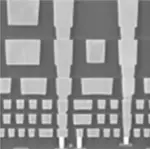 | Tox | 1.4 nm | Gate Dielectric | SiO2 |
| Vdd | 1.4 V | SRAM | 2.45 µm² | |||||||
| Lg | 70 nm | |||||||||
| CPP | 336 nm | MMP | 345 nm | |||||||
| 2003 | P1262 (CPU) P1263 (SoC, I/O) |
90 nm | 7 | Pentium M |  |
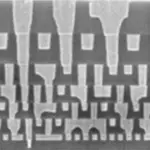 | Tox | 1.2 nm | Gate Dielectric | SiO2 |
| Vdd | 1.2 V | SRAM | 1.00 µm² | |||||||
| Lg | 50 nm | |||||||||
| CPP | 260 nm | MMP | 220 nm | |||||||
| 2005 | P1264 (CPU) P1265 (SoC, I/O) |
65 nm | 8 | Core, Modified Pentium M |
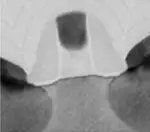 |
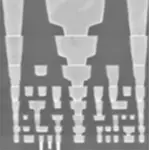 | Tox | 1.2 nm | Gate Dielectric | SiO2 |
| Vdd | SRAM | 0.570 µm² | ||||||||
| Lg | 35 nm | |||||||||
| CPP | 220 nm | MMP | 210 nm | |||||||
| 2007 | P1266 (CPU) P1267 (SoC, I/O) |
45 nm | 9 | Penryn, Nehalem |
 |
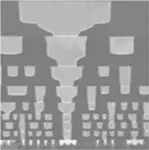 | Toxe | 1 nm | Gate Dielectric | High-κ |
| Vdd | SRAM | 0.346 µm² | ||||||||
| Lg | 25 nm | |||||||||
| CPP | 160 nm | MMP | 180 nm | |||||||
| 2009 | P1268 (CPU) P1269 (SoC, I/O) |
32 nm | 10 | Westmere, Sandy Bridge |
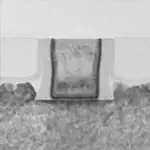 |
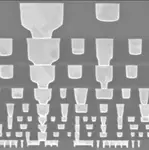 | Toxe | 1 nm | Gate Dielectric | High-κ |
| Vdd | 0.75 V | SRAM | 0.148 µm² | |||||||
| Lg | 30 nm | |||||||||
| CPP | 112.5 nm | MMP | 112.5 nm | |||||||
| 2011 | P1270 (CPU) P1271 (SoC, I/O) |
22 nm | 11 | Ivy Bridge, Haswell |
 |
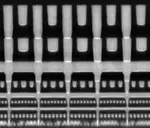 | Toxe | 0.9 nm | Gate Dielectric | High-κ |
| Vdd | 0.75 V | SRAM | 0.092 µm² | |||||||
| Lg | 26 nm | |||||||||
| CPP | 90 nm | MMP | 80 nm | |||||||
| Pfin | 60 nm | |||||||||
| Wfin | 8 nm | Hfin | 34 nm | |||||||
| 2014 | P1272 (CPU) P1273 (SoC, I/O) |
14 nm | 12 | Broadwell, Skylake, Kaby Lake, Coffee Lake, Cascade Lake, Comet Lake |
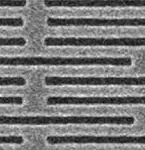 |
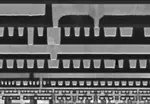 | Toxe | Gate Dielectric | High-κ | |
| Vdd | 0.70 V | SRAM | 0.0499 µm² | |||||||
| Lg | 20 nm | |||||||||
| CPP | 70 nm | MMP | 52 nm | |||||||
| Pfin | 42 nm | |||||||||
| Wfin | 8 nm | Hfin | 42-46 nm | |||||||
| 2019 | P1274 (CPU) P1275 (SoC, I/O) |
10 nm | 12-13 | Cannon Lake, Ice Lake, Tiger Lake, Alder Lake, Sapphire Rapids, Raptor Lake |
Toxe | Gate Dielectric | High-κ | |||
| Vdd | 0.70 V | SRAM | 0.0312 µm² | |||||||
| Lg | 18 nm | |||||||||
| CPP | 54 nm | MMP | 36 nm | |||||||
| Pfin | 34 nm | |||||||||
| Wfin | 7 nm | Hfin | 44-55 nm | |||||||
| 2021 | P1276 (CPU) P1277 (SoC, I/O) |
7 nm | Toxe | Gate Dielectric | ||||||
| Vdd | SRAM | |||||||||
| Lg | ||||||||||
| CPP | MMP | |||||||||
| Pfin | ||||||||||
| Wfin | Hfin | |||||||||
| 2024 | P1278 (CPU) P1279 (SoC, I/O) |
5 nm | Toxe | Gate Dielectric | ||||||
| Vdd | SRAM | |||||||||
| Lg | ||||||||||
| CPP | MMP | |||||||||
| Pfin | ||||||||||
| Wfin | Hfin | |||||||||
| 2027 | P1280 (CPU) P1281 (SoC, I/O) |
3 nm | Toxe | Gate Dielectric | ||||||
| Vdd | SRAM | |||||||||
| Lg | ||||||||||
| CPP | MMP | |||||||||
| Pfin | ||||||||||
| Wfin | Hfin | |||||||||
SRAM Scaling[edit]
For Intel, from 2 µm to 10 nm, SRAM 6T bit cells have had an average shrink of 0.496x in an attempt to maintain Moore's Law double density observation/requirement. Note that SRAM shrunk more significantly prior to the 65 nm process node. It should also be noted that logic typically scales better than the typical 6T SRAM cells, so raw logic density scaled more over time. Nonetheless, the size of the SRAM can be as much as three to four times the density of the typical logic cell.
Other processes[edit]
Semiconductor Process history by company:
- DEC
- Intel


